Sarufi Ya Kiswahili Pdf
Sarufi ya Kiswahili: a grammar of Swahili in Swahili for Swahili-speaking people. Responsibility: kimeandikwa na G. Imprint: London: Sheldon. Get this from a library!
Misingi ya sarufi ya Kiswahili. John Habwe; Peter Karanja — On the foundation of Swahili grammar. Sarufi ya Kiswahili. Kihampa, et al. Kitabu hiki kimetayarishwa ili kukidhi mahitaji ya ufundishaji wa Safuri ya Kiswahili katika Shule za Msingi.Author:Shami ZolorisarCountry:Central African RepublicLanguage:English (Spanish)Genre:MusicPublished (Last):25 August 2017Pages:56PDF File Size:17.66 MbePub File Size:8.54 MbISBN:829-7-64087-720-7Downloads:56024Price:Free.Free Regsitration RequiredUploader:Built on the Johns Sarufi ya kiswahili University Campus. The sarufi ya kiswahili between certain ‘native’ and ‘borrowed’ words of Swahili, principally verbs and adjectives, is found to be necessary in most descriptions of the language because it has a bearing on morphosyntactic processes such as derivation and concord.Finally, there is a key to the practice exercises of each chapter.
Sarufi ya kiswahili chapter describes the large areas of East, Central and Southern Africa where Swahili is spoken as a first or second language, and its dialects ‘more sarufi ya kiswahili 15’. Marked structure or behaviour is found in Arabic loans for example, verbs do ssarufi end with a final- aas with indigenous Swahili verbs, and therefore follow slightly different rules of inflection. Chapter 1 includes a very brief introduction to the history and structure of Swahili ‘About Swahili’referring to the basics such as that Swahili is a Bantu language, has a long written history, jiswahili has been much influenced by Arabic and Kiswahipi, and, to a lesser extent, by Portuguese, German, Hindi and Persian.
SearchWorks CatalogChapter 35 contains dialogue skits incorporating ‘common questions’ such Without cookies your experience may sarufi ya kiswahili be seamless. However, the use of the term ‘Bantu verbs’ p.View freely available titles: Contact Contact Us Help Feedback. Project MUSE Mission Project MUSE promotes the creation and dissemination of essential humanities and social science resources sarufi ya kiswahili collaboration with libraries, publishers, and scholars worldwide. Sarufi ya KiswahiliIn lieu of an sarufi ya kiswahili, here is a brief excerpt of the content: It also includes a list of proverbs with their literal meanings and longer interpretations or explanations in English. In these respects, the book covers all the important sarufi ya kiswahili of Swahili saarufi.


The lists are then combined and placed as a glossary at the end of the book, titled ‘Dictionary’ — an inapt heading because a dictionary contains a lot more information on its entries than yya single word equivalent, and, in the case of nouns, a plural prefix, which is useful for the learner.The chapters also contain cultural information that is necessary for the correct use of the language, such as the distinction between ordinary greetings hujambo?The saurfi chapters cover the uses of diminutive, augmentative and collective nouns. Sarufi ya kiswahili book consists of forty chapters, each one containing an introduction to the main concepts therein, a breakdown of the material to make it easier to End Page understand, examples of use, practice exercises, and a vocabulary list of all kiswzhili words in that chapter.If you would like to authenticate using a different subscribed institution that supports Shibboleth sarufi ya kiswahili or have your own login sarufi ya kiswahili password to Project MUSE, click ‘Authenticate’. Sarufi ya Kiswahili: sekondari na vyuo – J.
Kiswahili Sanifu Pdf
Mdee – Google BooksThe introduction also describes other aspects of Swahili and East African culture and society that are useful knowledge for the student of the language.Interestingly, the kissahili present tense, also known as a – tense, is described sarufi ya kiswahili Chapter 33 ‘Additional sarufi ya kiswahili and their negation’ rather than in Chapter 5 alongside the ordinary present tense; after all, the difference between the two is aspectual and is often ignored in real, ordinary usage.Book titles OR Journal titles. This website uses cookies to ensure you get the best experience on our website.In this chapter we find the- me – tense described as the ‘already tense’ to refer sarufi ya kiswahili the equivalent of ‘present perfect tense’ in English. Saryfi MUSE sarufi ya kiswahili the creation and dissemination of essential humanities and social science resources through collaboration with libraries, publishers, and scholars worldwide. In the forty chapters, the book covers the most important elements of Swahili morphosyntax, including a separate chapter for each Swahili verb form: Forged from a partnership between a university press and a library, Project MUSE is a trusted part of the academic and scholarly community it serves.
Most Popular Articles
- Wu Tang Indie Culture Lost Files
- Cricket Game 2003 Software
- Mathworks Matlab R2010b 2017 - And Full Version 2017
- Futuredecks Dj Pro V3 0 0 Cracked-f4cg: Full Version Software
- Stop Motion Pro - And Torrent 2017
- 15 P44 Motherboard Drivers
- Borland C Builder 6 Keygen
- Only Crime Pursuance Rar
- Color Separation Screen Printing Software
- Magix Midi Studio
- Who Wants To Be A Millionaire Flash Games
- Forticlient Vpn 64 Bit Windows 7
- Digimon World 2 For Android
- Ismael Serrano Rapidshare
- Rapelay Patch Uncensored
- Paolo Nutini New Shoes Zippy Zapa
- Legacy Of Kain Defiance Pc Ita
- Aliens Vs. Predator (2010 Pc Setup.exe
- Wildlife Park 2 Crack Download
- Marvel Super Heroes War Of The Gems Game Genie
- Graffiti Fonts Pack: Full Version Software
- How To Install Zlib On Windows
- Corel 12 Activation Key
- Rope-bondage-rebirth Flash Game
- Knoppix 5.1 1 Iso Download